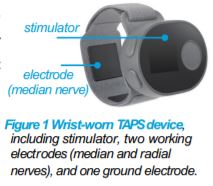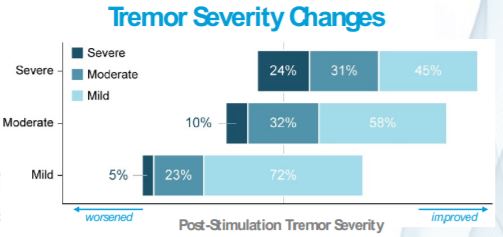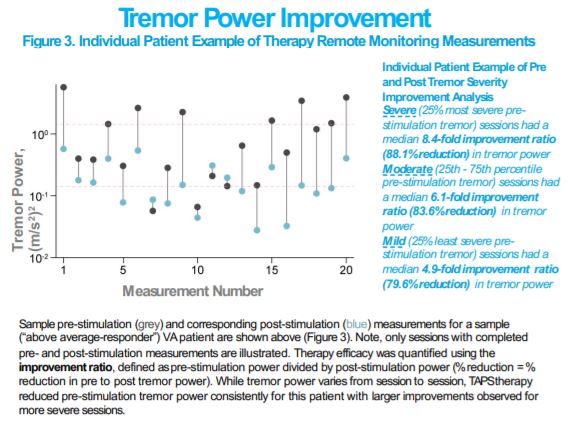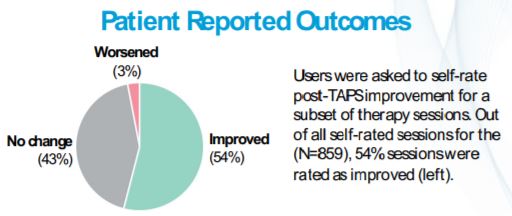 HINES, IL — Veterans are used to the sound of Taps marking an end. For a growing number, TAPS may indicate the beginning of a road to recovery of independence.
HINES, IL — Veterans are used to the sound of Taps marking an end. For a growing number, TAPS may indicate the beginning of a road to recovery of independence.
Transcutaneous afferent patterned stimulation (TAPS) is an application of bio-electronic medicine being used at the VA to treat veterans with essential tremor (ET), a common neurological condition that presents as a movement disorder.
ET affects about seven million people in the U.S. Typically, patients first experience shaking or tremors in the hands and arms, though some develop a “wobbly” voice, shake their heads, or have involuntary tremors in their legs or elsewhere. About half of individuals who develop ET have a family history of the condition. The risk of ET increases with age. While rare before the age of 40, it affects up to 5% of individuals over the age of 60.
ET can look like early Parkinson’s disease and both are treated through the VA’s Parkinson’s Disease Research, Education and Clinical Centers (PADRECC) network. The six PADRECC service areas each supports a Parkinson’s Disease Center of Excellence, which are located in Houston, Los Angeles, Philadelphia, Portland/Seattle, San Francisco, and Richmond, VA. These centers are staffed with specialists in movement disorders who conduct research, deliver clinical care, and provide educational programs to affected veterans.

Postural hold for TAPScalibration and tremor severity measurement. The device prompted users
to perform a postural hold for TAPScalibration, and before and after a subset of therapy sessions (first forty,
and every seventh thereafter). Atriaxial accelerometer on the device measured tremor motion during this
postural hold. Tremor severity was quantified using tremor power, computed from the accelerometer data.
While they may be confused with Parkinson’s movements, the tremors in ET typically occur primarily during activity. That can make everyday activities like writing, drinking water, eating, brushing teeth, and getting dressed increasingly difficult.
ET Treatment
“Essential tremor is one of the most common movement disorders in adults but is unfortunately met with unsatisfactory treatment options—ineffective medications and invasive surgery,” said Kalea Colletta, DO, a neurologist at the Edward Hines Jr. VAMC in Hines, IL. “I meet with patients from all walks of life, and each one deserves an easy-to-use therapy option for relief of their tremor symptoms.”
The only U.S. Food and Drug Administration-approved medication for ET is the beta blocker propranolol, though the International Essential Tremor Foundation (IETF) also gives the anticonvulsant primidone a level A recommendation for treatment. Other drugs used for ET include gabapentin, topiramate and several benzodiazepines. Many patients cannot tolerate the medications, and only 30% to 60% of those who can, find the drugs reduce their tremor. Patients who do respond typically experience a 30% to 50% reduction in tremors. “Tremor rarely completely resolves with medication,” according to the IEFT. Common adverse effects include dizziness, fatigue, sedation, cognitive issues, nausea and anorexia.
Surgical options focus on implantation of deep brain stimulating devices or focused ultrasound ablation targeting the ventral intermediate nucleus of the thalamus. Surgery reduces tremors in 35% to 75% of cases but cannot be adjusted, may worsen cognitive issues, and may lead to complications such as intracranial hemorrhage, edema, gait disturbances, headache, dysarthria and paresthesia.
In its latest recommendations, IETF added a watch-like TAPS device, the Cala Trio, as a new recommended therapeutic option. The device stimulates the median and radial nerves at the wrist. The nerves transmit the pulses to the central brain networks, where they are thought to disrupt the pathological tremor frequency signals that cause the hand tremors most common in ET. The device received FDA clearance for treatment of essential tremor in 2018.
Testing TAPS
Colletta and colleagues from the Temple VAMC in Temple, TX, the Los Angeles PADRECC, and Iowa City VA Health Care System presented results of a real-world study of TAPS for tremor control in veterans with ET at the International Parkinson and Movement Disorder Society (MDS) 2021 virtual congress held in September.1
The Cala Trio device consists of a stimulator and detachable band that contained electrodes placed to stimulate the median and radial nerves. Veterans learned how to set up the Cala Trio device, calibrate the stimulation to their tremor frequency, and find a stimulation intensity that did not cause pain. Veterans used the device on-demand for 40 minutes. The device recorded the time and duration of the sessions.
The device is available through the VA. Most patients (45%) were prescribed the device by a neurologist or a movement disorder specialist (38%). The team included 58 veterans who used the device for at least 30 days. They found that patients with mild tremors saw a 79.6% improvement, while those with moderate tremors had an 83.6% reduction in tremor power and those with severe tremors experienced an 88% reduction.

Click To Enlarge: TAPS therapy, when used during times of severe tremor, provided significant
tremor relief, with 76% of sessions improving to user-specific moderate or
mild ranges (above, top row). TAPS therapy when used during times of mild
tremor maintained that mild tremor in 72% of sessions, suggesting TAPS can
also be used prophylactically
“TAPS therapy, when used during times of severe tremor, provided significant tremor relief, with 76% of sessions improving to user-specific moderate or mild ranges,” the team noted in their presentation. “TAPS therapy when used during times of mild tremor maintained that mild tremor in 72% of sessions, suggesting TAPS can also be used prophylactically.”
In a subset of 24 veterans for whom the researchers had pre- and post-stimulation motion capture data for 10 or more sessions, half of users had twofold or greater improvement in tremor intensity and 91% experienced some improvement after a month of device use on an as needed basis.
The adjustable stimulation allow adaptation to each patient’s physiology. “The evidence presented at the MDS virtual conference highlights how personalized Cala Trio is and just how impactful it can be in treating patients with mild to severe tremor symptoms,” Colletta said.
Air Force veteran Ben Duncan had such bad tremors that his wife had to feed him. “Now with the simple use of the device, I can write clearly, grasp and hold glasses without spilling, I feel like I am back to my normal self again,” he said.
- Colletta K, Borucki S, Fujikawa D Handforth C, Phan A, Killoran A, Li A, Rosenbluth K. Real-world Evidence Supports use of Transcutaneous Afferent Patterned Stimulator for Tremor Control in Veterans Affairs Essential Tremor Patients. MDS 2021. September 15, 2021.



